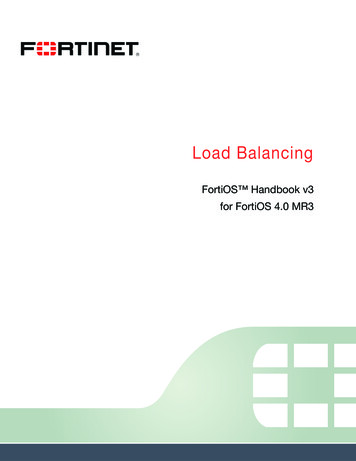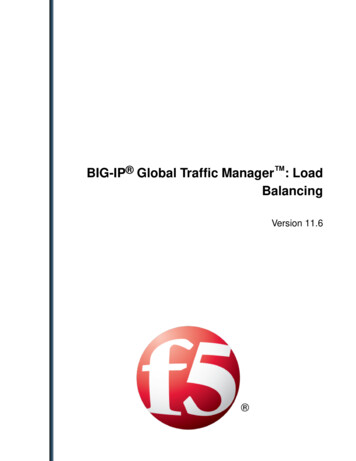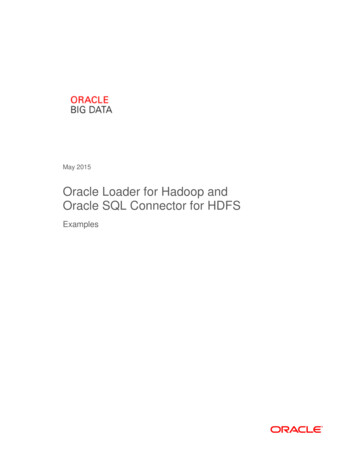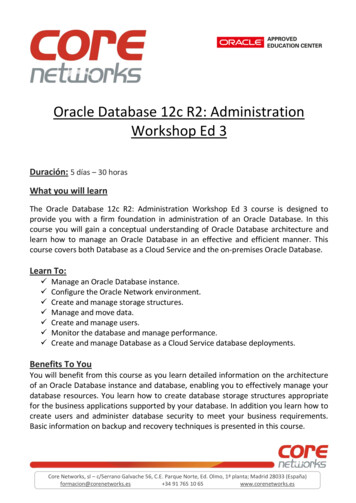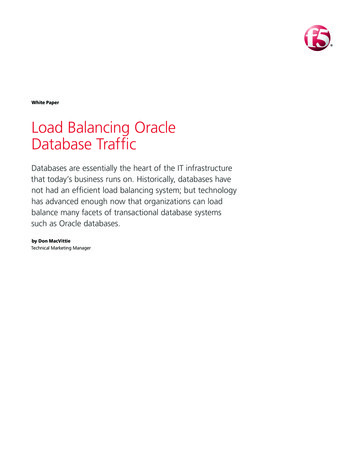
Transcription
White PaperLoad Balancing OracleDatabase TrafficDatabases are essentially the heart of the IT infrastructurethat today’s business runs on. Historically, databases havenot had an efficient load balancing system; but technologyhas advanced enough now that organizations can loadbalance many facets of transactional database systemssuch as Oracle databases.by Don MacVittieTechnical Marketing Manager
White PaperLoad Balancing Oracle Database TrafficContentsIntroduction3Database Management Systems4Load Balancing Clustered Databases4Load Balancing All Databases5Replication Enhancement7The BIG-IP System and Oracle8Conclusion102
White PaperLoad Balancing Oracle Database TrafficIntroductionThere is very little debate about the importance of databases in the corporate datacenter—without them, business would grind to a halt. Unstructured data is growingat a much faster pace than structured data, but structured data represents anorganization’s accumulated knowledge about customers, orders, suppliers,and even employees. Yet effective load balancing for mainstream databasemanagement systems (DBMSs) has escaped the industry for many years. Thisis partially due to the transactional nature of DBMS traffic, and partially to thecritical nature of databases. Anything that inserts another potential point of failurebetween databases and the applications they service has been viewed with a highlevel of skepticism.Advances in database technology and the proven track record of ApplicationDelivery Controllers (ADCs) have merged to change the face of the marketplace.Once database clusters became relatively common, it was a matter of time beforeusers realized that clustering is, in many senses, software-implemented loadbalancing. In the meantime, ADCs came of age, offering load balancing and awhole host of other functionality from monitoring to security. The number ofapplications sitting behind ADCs, combined with the growth in databaseclustering and increasing desire for high availability solutions at the databaselevel, naturally led to organizations using ADCs to balance the workload ofDBMS products.Some more cautious organizations utilize ADCs to speed access and switchoverfor DBMSs; other, less risk-averse organizations are pushing the boundaries withoutright DBMS load balancing. Organizations with larger database workloadsutilize database clustering, while those with smaller loads generally approachthe problem from a stand-alone database perspective.In any organization, IT staff must determine whether load balancing databases isin their best interests and if so, which features are best suited to their architecture.F5 products provide various options for load balancing these highly complexcritical systems, so organizations can ensure their DBMS architectures are moresecure, fast, and available.F5 Speeds Oracle“We have been able to deployOracle globally and mitigate theeffects of latency due todistance with the webacceleration technologiesimplemented in F5 products.Oracle performs better andmore predictability for our usersthroughout the world.”Senior IT Architect, LargeEnterprise ConstructionCompanySource: TechValidateTVID: D48-242-1663
White PaperLoad Balancing Oracle Database TrafficDatabase Management SystemsDatabase management systems rely on network connections to do their tasks insupport of applications. This makes them a natural target for load balancing at thenetwork level.But there are significant challenges to load balancing DBMSs. First and foremost,a DBMS is assumed to have access to all of the records for a particular table, whichimplies that the database is updated directly. When load balancing across DBMSs,how can it be arranged such that all instances have access to all data for all tables?DBMSs also require transactional integrity to guarantee that all of the changesrelevant to a transaction complete, or else the entire transaction doesn’t complete.Transactional integrity has been one of the limiting factors of DBMS load balancing.If load is being distributed across multiple databases, how does IT guarantee thatall of the elements of a single transaction go to a single instance of the databaseso that transactional integrity is insured?When IT utilizes clustered databases, these issues are handled at the clusteringsoftware layer. The software ensures that that each instance has access to the entiredatabase, and sends connections to the correct instance.But there is always room for improvement, and clustering is no exception. WhenOracle database clusters are deployed, a server that encounters problems and goesoffline may take a significant amount of time to notify applications. Applicationsthat are Oracle Fast Application Notification (FAN) enabled will be notified quickly,while other applications—the bulk of the application infrastructure—will take muchlonger to realize there is a problem and reconnect to the cluster to get access to avalid server.Load Balancing Clustered DatabasesLoad balancing clustered databases isn’t actually load balancing, per se, butrather a way to create a highly available infrastructure between database clusters.F5 BIG-IP Local Traffic Manager (LTM), an ADC, uses a variety of monitors tocheck the health of pool members, so if the primary and secondary clusters areconfigured as members of a single pool and utilize priority queuing, when theprimary goes down, the secondary will automatically receive the traffic. This is onesmall bit of a complex architecture, but it is an enabling part that automates failoverso that there is no delay while administrators are notified of a problem, go to look4
White PaperLoad Balancing Oracle Database Trafficinto the problem, and then manually make the exact same switch. Since BIG-IP LTMprovides the connection address for applications utilizing the database (as a virtual IPin front of the pool), switchover doesn’t require any IP address juggling exercises oneither server or client applications.ClientsApplicationServersBIG-IPLocal Traffic ManagerOracle Database 11g(Primary Cluster)Oracle Database 11g(Standby Cluster)Figure 1: BIG-IP LTM manages failover for clustered Oracle Database 11g.This is the easiest solution to implement because there are no heavy data orsoftware architecture requirements beyond the choice to use high availabilityclusters. Using multiple clusters, without BIG-IP LTM, requires that IT have areplication system in place that is near real time, or the idea of failover won’t workto begin with. There must be a mechanism for that replication to be two-way, sothat whichever system is active is feeding back to the one that is not. All of theseare requirements of utilizing multiple clusters, not of using BIG-IP LTM to provide ahigh-performance, highly tunable failover between the clusters.Load Balancing All DatabasesWithout BIG-IP LTM, applications that conform to Oracle’s FAN failover systemcan fail over quickly and gracefully. BIG-IP LTM extends that failover ability to alldatabase applications. Given the number of applications that do not supportFAN, this is a huge benefit in the short term. BIG-IP LTM achieves this with twoautomation tools. The first is a set of iControl scripts, which extend FAN to the5
White PaperLoad Balancing Oracle Database TrafficBIG-IP system by marking a node as down on the BIG-IP device if FAN reports it asdown, and up if FAN later reports it as being back up. The second automation toolis built into BIG-IP LTM, and is an easy-to-use configuration setting that instructs theBIG-IP device to reject connections to devices marked as down. Since BIG-IP LTM isa full TCP proxy, if this configuration setting is turned on, when FAN marks a nodeas down, it is reflected in the status of the node on BIG-IP LTM; thus connectionsattempting to reach the downed node are rejected by the BIG-IP device. This startsthe process of the application reconnecting to a new database server that canhandle application requests.ClientsApplicationServersBIG-IPLocal Traffic ManageriControlScriptif { cache mbrne "" } {if { [IP::addr[IP::remote addrOracle Database 11g(Primary Databases)Oracle Database 11g(Standby Databases)Figure 2: BIG-IP LTM extends FAN notifications to all applications, not just those built on theOracle JVM.With BIG-IP LTM standing between the application and the databases, acting asa full TCP proxy with knowledge of the state of database servers, connections canbe reset immediately upon attempting to communicate with a downed server. Thiscan happen when a server goes down in the middle of a communications stream.BIG-IP LTM marks the database as down, and when the next request comes fromthe server, BIG-IP LTM resets the connection, forcing the application to a differentdatabase upon return. For applications that are not FAN-enabled, Oracle usesindustry-standard TCP timeouts as the notification mechanism. While this offersthe broadest possible support for applications, it is too slow for many environments,as the application has to send a request and then wait for the TCP timeout intervalbefore determining that it must reset the connection.6
White PaperLoad Balancing Oracle Database TrafficBIG-IP LTM also offloads monitoring from Oracle. From BIG-IP LTM, a single copyof the SQL query utilized to check the status of Oracle databases can be applied toall Oracle instances. This reduces the opportunity for error by removing manyredundant copies of this script from around the network. It also reduces networktraffic and management time by enabling IT staff to control frequency or pings froma centralized location via health monitors built in to the BIG-IP system and the querydesigned to test Oracle status.And as with all applications placed behind BIG-IP LTM, if administrators need toperform maintenance, connections to the database can be gracefully bled off of asingle database server until there are zero connections. There is no need to kill offall active connections to take the server down; rather, the administrator can justmark it as not accepting new connections, and let the connections slowly drainaway as each is completed. In the case of an Oracle Real Application Cluster (RAC),this would have the effect of sending new connections to the other servers in thecluster. In a standalone database environment, this would have the similar effectof shipping all connections to the redundant database(s). When maintenance iscomplete, the administrator can return the server to the pool, and it will resumeaccepting connections as if it had never left.In a nutshell, BIG-IP LTM gives organizations faster connection resets when adatabase or entire cluster goes offline, centralized management of SQL scripts fortesting, extension of FAN to non–FAN enabled applications, and the ability to takeservers out of the pool to perform maintenance or even replace the hardware.Replication EnhancementIt is impossible to load balance applications across databases unless those databasesare synchronized in some manner. While there are a variety of ways to handlereplicating the contents of a database, by far the most common is to make onedatabase the master and one the secondary, then replicate changes to the masterthrough to the secondary. This process is well supported by Oracle and third parties,and works with varying degrees of success depending on the situation. In general,as the distance the data has to be transported and the volume of that data bothgrow, the more performance of applications designed for replication degrades.Since most of the replication applications on the market today have their rootsin LAN-only replication, this is not surprising; but replication over the WAN isbecoming more prevalent, causing major problems.7
White PaperLoad Balancing Oracle Database TrafficOracle offers many options for replicating databases, and these products workvery well over the LAN. However, these same products perform less well over theWAN, where there are a whole different set of points at which performance candegrade. BIG-IP WAN Optimization Manager (WOM) helps products like OracleGoldenGate speed data replication from one data center to another by enhancingthe performance of the WAN. In testing the results were dramatic, with as muchas a 65x improvement in throughput for database replication.Data GuardRecovery ManagerStreamsData Store GoldenGateBIG-IP Local Traffic Manager WAN Optimization ManagerWAN IP Local Traffic Manager WAN Optimization ManagerData Center 1Data GuardRecovery ManagerStreamsGoldenGate Data StoreData Center 2Figure 3: BIG-IP WOM improves throughput on the WAN, speeding replication.BIG-IP WOM also offloads encryption from the database, which improves notonly the performance of replication, but the overall performance of the databaseitself. Encryption is a CPU-intensive operation that does not have to occur on eachserver when a BIG-IP device can handle encryption and decryption at the point ofnecessity. This can help stave off equipment upgrades by freeing CPU processingtime for database-centric applications. Moving data into and out of the cloudwill play an increasing role in the data center, and encrypting all outgoing databefore it enters public space has become all but mandatory for enterprise-classimplementations. Offloading that encryption to BIG-IP hardware specificallydesigned to handle high-volume, large-key encryption will save a lot ofprocessing power on database servers.While encryption is important, offloading compression to BIG-IP WOM alsoimproves database performance by saving CPU cycles for database processing.The BIG-IP System and OracleThe way in which organizations benefit from using BIG-IP products whenload balancing Oracle databases varies depending on whether the applicationinfrastructure is a pure Oracle stack (meaning all applications are developed solelyusing the Oracle client libraries or an Oracle JVM) or a heterogeneous stack(meaning some applications use some non-Oracle development tools).8
White PaperLoad Balancing Oracle Database TrafficPure Oracle StackFeatureOracle StandaloneOracle BIG-IP SystemMonitoringApplication SQL PingOffload to BIG-IP (one per cluster*)TCP failoverUCM Connection PoolProvided by Oracle NetTCP optimizationsManual Oracle Net TuningProvided by Oracle NetHigh availabilityNode VIP/Scan IPBIG-IP system if monitoring enabledLoad balancingFAN—Runtime Load BalancingProvided by Oracle NetWorkload managementFAN—Workload AdvisoryProvided by Oracle NetFailure managementFAN messagesProvided by Oracle Net*One per node in version 10 of TMOSFigure 4: How the BIG-IP system benefits a pure Oracle stack (a 100 percentOracle FAN–capable software architecture).In the pure Oracle stack scenario, SQL Ping is centralized at the BIG-IP device, withone or several scripts managing Ping on a schedule best suited to the environment.Additionally, the BIG-IP system can handle high availability if monitoring is turned on.Heterogeneous StackFeatureOracle StandaloneOracle BIG-IP SystemMonitoringApplication SQL PingOffload to BIG-IP (one per cluster*)TCP failoverOracle Net TimeoutBIG-IP system, connection resetTCP optimizationsManual Oracle Net TuningBIG-IP system profilesHigh availabilityOracle Node VIP/Scan IPBIG-IP system, VIP/poolLoad balancingOracle Net Connection StringBIG-IP system, instance/name switchingWorkload managementNot availableBIG-IP iControl scriptFailure managementNot availableBIG-IP iControl script*One per node in version 10 of TMOSFigure 5: How the BIG-IP system benefits a heterogeneous stack (not a 100 percentOracle FAN–compatible infrastructure).The benefits of using the BIG-IP system in a load balancing configuration are moresweeping when there are applications in the data center that utilize databaseaccess methods other than the Oracle SQL libraries. Since “applications” includespurchased applications, this is the more common scenario. The BIG-IP systemoffers all of the functionality that would normally be offered by FAN, and takesover functions that are not well supported in applications that were not built withOracle client libraries.9
White PaperLoad Balancing Oracle Database TrafficConclusionAs workloads continue to increase, organizations will use both load balancing andclustering databases to meet performance goals with commercial, off-the-shelfservers. These methods offer many positive options for database administrators,including high availability through redundancy and load sharing.F5 BIG-IP products help improve the performance of database clusters by expandingOracle FAN out to non–FAN enabled clients, thus offering fast connection resets.They also help to load balance non-clustered databases by enabling administratorsto bring a database out of production and perform maintenance on it without usersnoticing that the database is changing. Finally, BIG-IP products help keep remotedatabase replicas synchronized so that shifting load to a replica has a greaterprobability of success and replication actions take significantly less time, which helpsmeet RPO and RTO requirements—all while improving performance by offloadingencryption and compression.With databases being such a significant part of the information infrastructure, itis imperative that they be secure, fast, and available. This requires more than justa simple standalone DBMS, and F5 products provide the extra layer to Oracledatabases that helps IT management ensure that systems designed around thedatabase are available to users in nearly any circumstance.F5 Networks, Inc. 401 Elliott Avenue West, Seattle, WA 98119F5 Networks, Inc.Corporate Headquartersinfo@f5.comF5 NetworksAsia-Pacificapacinfo@f5.com888-882-4447F5 Networks .comF5 NetworksJapan K.K.f5j-info@f5.com 2012 F5 Networks, Inc. All rights reserved. F5, F5 Networks, the F5 logo, and IT agility. Your way., are trademarks of F5 Networks, Inc. in the U.S. and in certain other countries. Other F5 trademarks are identifiedat f5.com. Any other products, services, or company names referenced herein may be trademarks of their respective owners with no endorsement or affiliation, express or implied, claimed by F5. CS01-00091 0412
Load Balancing Clustered Databases Load balancing clustered databases isn’t actually load balancing, per se, but rather a way to create a highly available infrastructure between database clusters. F5 BIG-IP Local Traf

